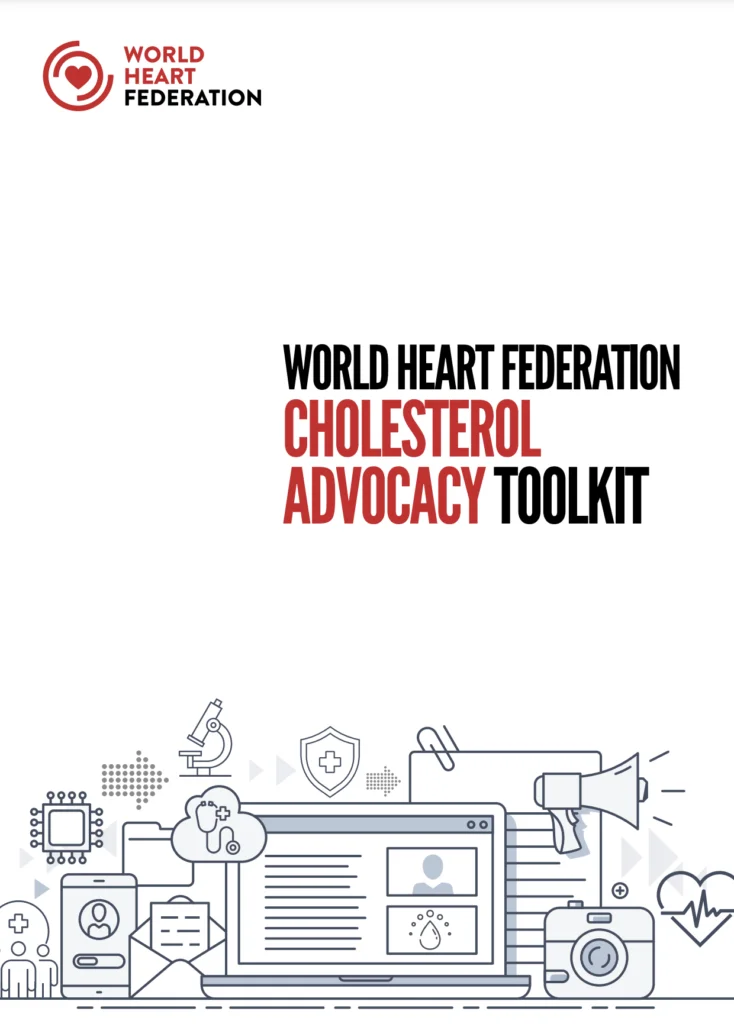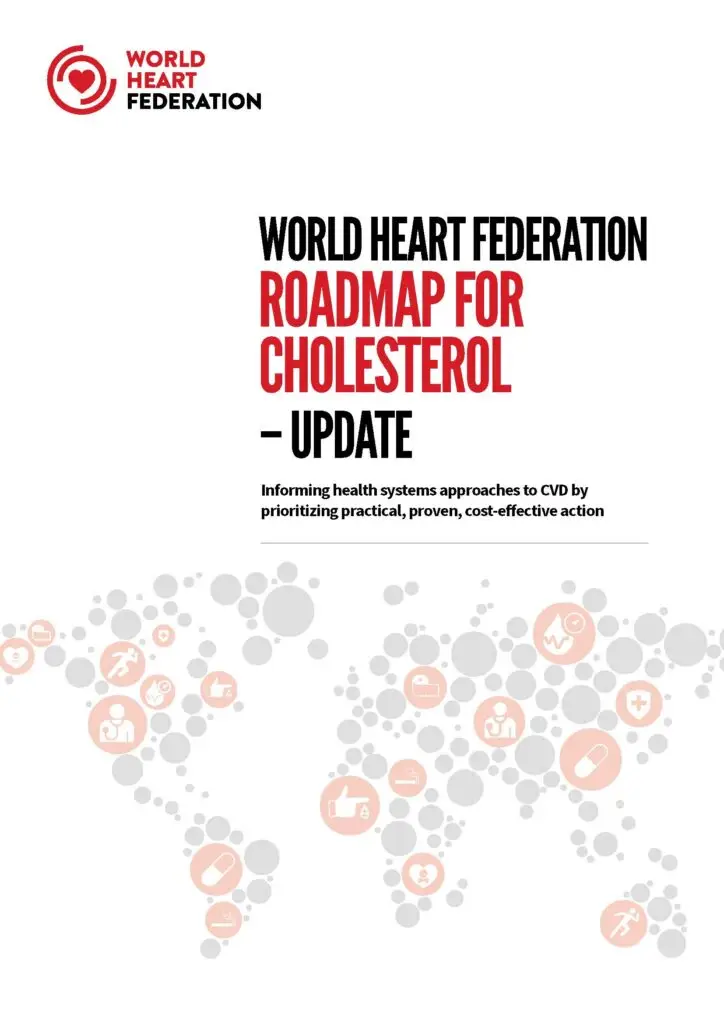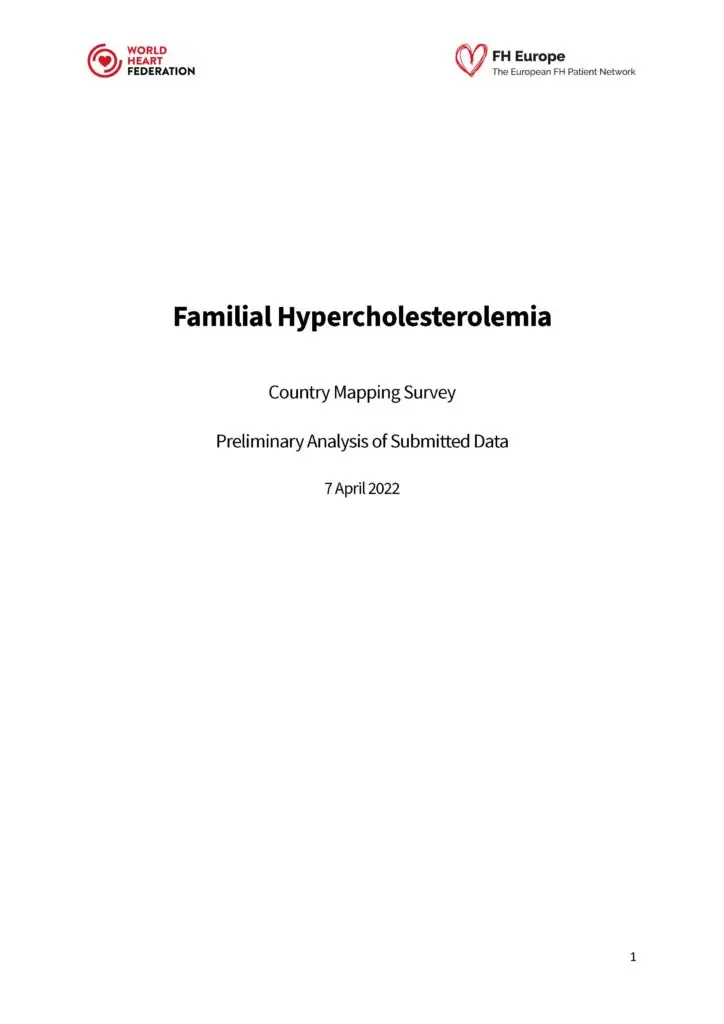High cholesterol causes 4.4 million deaths every year, or 7.8% of all deaths.
High cholesterol causes 4.4 million deaths every year.
It is a major a risk factor for heart disease and stroke in both high- and low-income countries.
A healthy diet, regular exercise and medication can help reduce high cholesterol.
Cholesterol is a waxy, fat-like substance found in your blood. The liver either makes cholesterol or uses cholesterol obtained from other sources: dietary cholesterol and saturated fat, cholesterol carried in the blood, or by reabsorbing bile from the gastrointestinal tract.
Cholesterol is crucial to the healthy functioning of the body, which needs it to build healthy cells and make vitamins and other hormones. But too much cholesterol can lead to serious problems, including heart disease and stroke.
High blood cholesterol is one of the major controllable risk factors for heart disease, heart attack and stroke.
24%
of CVD-related deaths are attributable to high LDL cholesterol
In 2008, 39% of adults around the world had high total cholesterol
Cholesterol is carried through your blood attached to proteins. This combination of proteins and cholesterol is called a lipoprotein. There are different types of cholesterol, based on what the lipoprotein carries: low-density lipoprotein (LDL) and high-density lipoprotein (HDL):
LDL is sometimes called bad cholesterol because it can build up inside our arteries, causing them to harden and narrow (a process called atherosclerosis) and limiting blood flow. This can ultimately lead to a heart attack or stroke.
HDL is often referred to as “good” cholesterol, because it carries unnecessary cholesterol away from our arteries and back to our liver, where it’s broken down and eliminated from the body. A healthy level of HDL cholesterol can protect against heart attack and stroke.
A third component, known as triglycerides, also plays a role in our cholesterol health. They are the most common type of fat in our bodies, and they store excess energy, or fat, from our diet. Being overweight, eating a lot of fatty and sugary foods or drinking too much alcohol may lead to raised blood triglyceride levels. Triglyceride levels may be high despite relatively normal levels of good cholesterol and non-HDL cholesterol.
A high triglyceride level, combined with low HDL and high LDL, can increase the risk of cardiovascular disease.
Dyslipidaemia is an all-encompassing term which refers to the presence of non-optimal levels of blood lipids. In clinical practice guidelines, it is typically characterized by raised total cholesterol and/or low-density lipoprotein cholesterol. The definition is also often extended to include nonoptimal levels of high-density lipoprotein cholesterol, triglyceride, apolipoprotein B and apolipoprotein A1.
Familial hypercholesterolemia (FH) is a genetic condition that causes high cholesterol and affects approximately 34 million people worldwide, or one in 200-250 people. If left untreated, FH leads to early heart attacks and heart disease. Individuals with FH have a high amount of LDL cholesterol or ‘bad cholesterol’ due to a mutation in one of several genes that control how the liver uses cholesterol. As a result, cholesterol accumulates in the bloodstream and can ultimately build up in the arteries’ walls. Patients may develop fatty skin deposits, known as xanthomas, on their body or cholesterol deposits may also be visible on the eyelids, a condition called xanthelasmas.
FH is inherited. The number of mutations that are inherited determine the type of FH an individual has. One inherited mutation – called Heterozygous Familial Hypercholesterolemia (HeFH) – means that one abnormal mutation is passed down to a child, typically from one parent. Two inherited mutations – called Homozygous Familial Hypercholesterolemia (HoFH) – happen when a mutation for HeFH is passed on from each parent to their child. This results in the more rare and severe form of FH.
Hypercholersterolemia and Familial Hypercholesterolemia are largely silent diseases; they cause no symptoms. As a result, they too often remain unnoticed. When diagnosed, treatment is not systematic, and patients have poorly controlled cholesterol levels. FH remains mostly underdiagnosed and undertreated due to low awareness, both among the public and among health professionals – only 10% of those affected know about their condition and are adequately treated.
Lipoprotein(a), often abbreviated as Lp(a), is a type of lipoprotein, composed of proteins and fats, found in the blood. Like LDL (low-density lipoprotein), often referred to as “bad cholesterol”, Lp(a) contains cholesterol within its structure.
Lp(a) can increase the risk of heart disease when present in elevated levels. High levels of Lp(a) are inherited and affect 1 in 5 people.
High cholesterol can be inherited, but it’s often the result of unhealthy lifestyle choices, such as inactivity, smoking and an unhealthy diet. Metabolic conditions such as type 2 diabetes can also influence an individual’s cholesterol and triglyceride levels.
Behavioural risk factors
Unhealthy diet: A diet high in saturated fat (found, for example, in animal products) and trans fats (found in various industrially processed foods) can lead to an increase in cholesterol levels. Excess sugar and starch intake contributes to high triglycerides.
Physical inactivity: Being physically inactive can have a detrimental effect on non-HDL cholesterol levels. regular physical activity as been shown to have a beneficial impact by reducing non-HDL cholesterol concentrations.
Smoking: Cigarette smoking damages the walls of the blood vessels, making them more likely to accumulate fatty deposits. Smokers are 2-4 times more likely to develop heart disease than non-smokers. Conversely, smoking cessation typically leads to an increase in HDL cholesterol levels.
Associated conditions
Obesity: The typical dyslipidaemia of obesity consists of increased triglycerides, decreased HDL cholesterol with HDL dysfunction, and normal or slightly increased non-HDL cholesterol.
Diabetes: High blood sugar reflects in part greater insulin insensitivity which contributes to higher levels of very low-density lipoprotein (VLDL) production by the liver and in turn lower HDL cholesterol. High blood sugars from Diabetes may also directly damage the lining of the blood vessels.
Non-modifiable risk factors
Heredity: The quantity of cholesterol produced by the body is partly genetically determined. Familial hypercholesterolemia (FH) leads to high cholesterol and, if untreated, to early heart attacks and heart disease. Each child of an individual with FH has a 50% chance of inheriting the disorder. There are many genes that impact cholesterol levels by small increments; having a lot of these genes that raise cholesterol is also not healthy. Therefore, screening parents, siblings, and children of a person diagnosed with FH to find others who may have inherited the genes is essential.
Age: Growing older constitutes a risk factor, as metabolism changes as with advancing age and may predispose individuals to dyslipidemia. For instance, with advancing age, the liver becomes less able to remove cholesterol containing lipoproteins. Furthermore, age reflects years of exposure to undesirable factors. The earlier one reduces this, the better one is able to age in a healthy fashion.
Gender: High cholesterol affects both men and women. However, oestrogen, a female hormone, raises HDL cholesterol levels, partially explaining the lower risk of CVD observed in pre-menopausal women. Conversely, LDL-cholesterol rises after menopause, which again increases the risk in post-menopausal women.
High cholesterol is also in itself a risk factor for serious health conditions. If left untreated, it can lead to atherosclerosis. This, in turn, may lead to heart disease, stroke, and other vascular diseases. The higher the LDL, the higher the risk.
High cholesterol has no symptoms. The only way to know if you have high cholesterol levels is to have a simple blood test.
Cholesterol levels should be measured at least once every 5 years in everyone over age 20. Men aged over 35, women aged over 45 and people with a family history of high cholesterol, heart disease or other risk factors, such as diabetes or high blood pressure, are at higher risk of cholesterol and should therefore be screened more frequently.
Because of its silent nature, high cholesterol often remains undiagnosed.
Although medication such as statins can help control excess cholesterol or its potentially damaging impacts, lifestyle and genetics also play a role, so staying informed about risk factors is a major first step.
The same heart-healthy lifestyle changes that can lower your cholesterol can help prevent you from having high cholesterol in the first place. This includes:
- Eating a low-salt diet that emphasizes fruits, vegetables and whole grains
- Limiting the amount of animal fats and use good fats in moderation
- Maintaining a healthy body weight
- Quitting smoking
- Getting plenty of physical activity (at least 30 minutes every day)
- Drinking alcohol in moderation, if at all
- Managing your stress levels
Controlling your cholesterol may be easier than you think, but it all starts with getting your cholesterol checked.
Although high cholesterol can be easily reduced or treated with inexpensive and cost-effective medications, these treatments remain inaccessible to broad segments of the world’s population. Statins are included on the WHO List of Essential Medicines but their availability and affordability remain a hurdle in certain settings. Other barriers – costs, misconceptions about medication, forgetfulness, also lead to treatment discontinuation.
Globally, raised total cholesterol affects approximately 39% of adults. In 2019, the number of DALYs (disability-adjusted life years) due to high non-HDL cholesterol reached 98.6 million. It also caused an estimated 4.4 million deaths. From a regional perspective, the death toll has decreased in high-income western countries. Conversely, it has more than doubled in southeast Asia and even tripled in east Asia. As a result, by 2017, half of the deaths attributable to high non-HDL cholesterol were recorded in east, southeast, and south Asia, compared with a quarter in 1990. This demonstrates a global shift of the disease burden from high-income countries in north-western Europe, North America, and Australasia to middle-income countries in east and southeast Asia, as well as some countries in Oceania and central Latin America.
The World Heart Federation Roadmap on Cholesterol identifies roadblocks and suggests potential solutions to improve cardiovascular health and help reach the target set out in the Sustainable Development Goals: achieve a 30% reduction in NCDs, including CVD, by 2030.
The WHF Roadmap for Cholesterol – 2022 Update aims to reduce the global burden of atherosclerotic cardiovascular disease, which is responsible for 85% of the 18.6 million cardiovascular disease-related deaths worldwide every year. Atherosclerosis is a silent condition caused by high cholesterol that develops throughout a person’s lifespan and can lead to sudden death. The new Roadmap, which builds on the previous 2017 edition, shows how targeting cholesterol can help reduce atherosclerotic cardiovascular disease and save lives.
FAMILIAL HYPERCHOLESTEROLEMIA
Familial hypercholesterolemia (FH) is a genetic condition that causes high cholesterol and affects approximately 34 million people worldwide.
Find out moreHeart Heroes
Discover more Heart Hero Stories


Latest News
Advocating for cholesterol control: A World Heart Federation toolkit
Cardiovascular disease is responsible for an estimated 18.6 million deaths every year and remains the leading cause of mortality worldwide. Raised cholesterol is widely recognized as a major risk factor for heart disease and stroke. According to the Global Burden of Disease Study, approximately 4.4 million deaths were attributable to elevated LDL cholesterol in 2019. […]
Cholesterol
Cholesterol risks and remedies: A Roadmap to improve cardiovascular health
Increasingly, evidence is equipping us with ways to manage our blood cholesterol levels that can mitigate or prevent dangerous cardiovascular conditions. The updated World Heart Federation Roadmap for Cholesterol delves into the epidemiology, diagnosis, treatment, and policies for better outcomes and highlights implementation case studies. The Roadmap focuses on approaches to reduce atherosclerosis and atherosclerotic […]
Cholesterol
Taking a stance on cholesterol to curb heart disease
Cholesterol – that waxy substance that is a type of blood fat or lipid – is mostly made by our own bodies and the rest, we get from food. Our tissues, skin, and hormones all benefit from cholesterol which gets around the body, attached to proteins. Trouble arises, however, when low-density lipoprotein (LDL) cholesterol is […]
Cholesterol
Global Call To Action on Familial Hypercholesterolemia Aims to Improve Diagnosis and Treatment Worldwide
PASADENA, Calif., GENEVA, Switzerland, January 2, 2020 — The FH Foundation and the World Heart Federation announced today a Global Call to Action on familial hypercholesterolemia (FH), a vastly under-recognized and poorly managed public health concern. Published in JAMA Cardiology and authored by a global panel of scientific experts, advocacy leaders, public health officials, and […]
Cholesterol




